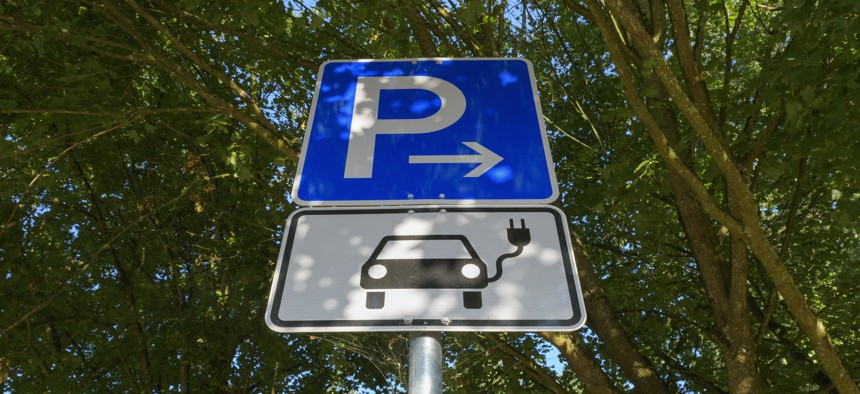4 Considerations for Building Out Electric Vehicle Charging Stations

imageBROKER/Raimund Linke via Getty Images
COMMENTARY | Policymakers and businesses will need to make important choices about chargers as more EVs hit the road. Here are some key things to keep in mind.
The quiet hum of electric vehicles is starting to replace the roar of internal combustion engines on our roadways as the world moves toward zero-emission transportation solutions.
In 2021, EV sales grew worldwide by an estimated 109% from 2020 and were on a similar trajectory in the first half of 2022. AutoPacific forecasts that almost 700,000 full-battery EVs will be sold in the U.S. in 2022, with that number predicted to reach 2.5 million by the end of 2027.
As the number of electric vehicles on the road increases, it is imperative to scale up charging infrastructure.
This is a challenge and an opportunity for local governments and businesses. With $5 billion from the National Electric Vehicle Infrastructure, or NEVI, program headed to states and $2.5 billion in additional grant funds for local charging infrastructure, now is the time for states and municipalities to ramp up their focus on EV chargers.
NEVI will fund the installation of at least 500,000 additional charging stations in the United States by 2030. Funds from the program will be dispersed to states over five years, with the priority being to build chargers in Alternative Fuel Corridors, mainly along the interstate highway system. With NEVI in mind, real estate owners, charger operators, municipalities and others need to think about how and where to install EV charging stations.
First-to-market adopters of public EV charging stations will benefit. For instance, EV owners who can get a fast charge at a convenient retail location will be more likely to shop there while charging. In addition, EV charging stations provide business owners extra revenue streams through charging fees and integrated marketing — all while showcasing the retailer’s commitment to sustainability.
Considerations for EV Charging Stations
EV drivers have unique needs. That means user-specific charging scenarios are required to support a variety of driver behaviors, which differ from the traditional gasoline fueling station model.
For example, long-distance drivers require fast-charging stations near highway exits. Although most EV owners currently charge their vehicles at home, many drivers live in apartments or housing where it might be difficult to install private charging stations. These drivers will need to seek out neighborhood locations, such as municipal lots, garages or on-street stations.
Similarly, EV fleet operators might have longer distances or shorter dwell times than the average commuter and might desire direct current fast-charging stations along their heavily traveled routes. For example, delivery trucks and city buses looking to charge will want charging ports in locations along their existing routes for maximum efficiency.
Companies and governments will need to plot out the logistics of charging stations thoughtfully. Some factors owners and operators should consider include:
1. Charging power and plug type. All EV charging stations are not created equal because vehicles recharge at differing rates. Determining the power level to offer is critical in terms of cost and user experience. The plug type is also important to consider because there are multiple plug types in use today, even though the industry is moving toward a standard.
2. Access to grid power. It is preferable to install EV chargers close to power service to reduce the size and cost of installation. In some cases, integration with on-site renewable energy production is ideal because it can generate some or all the electricity needed for charging. It is vital to work with your utility provider to ensure that the grid can supply sufficient power and with the local jurisdiction to obtain the needed permits and inspections.
3. Review building codes for Americans with Disabilities Act compliance. Some EV drivers might require accommodations when using charging stations, and local codes are being developed requiring a certain number of spaces to be wheelchair accessible. In addition, plugs aren’t always located in the same place on EVs. It is important to ensure the parking location has ample space for the driver to access the plug on their EV — which might be on any side of the vehicle — and that it is in a safe and secure area so that individuals with disabilities can access the area.
4. Social equity. As electric vehicles continue to move beyond the early adopters in urban areas and into the mainstream, it will be essential to ensure all citizens have access to charging equipment. This means proper infrastructure planning must include equitable coverage in underprivileged communities and rural America.
EV adoption is going to continue to accelerate. To stay ahead of the curve, government, real estate owners, and other stakeholders need to develop sensible, achievable and scalable charging infrastructure plans.
Daniel Ciarcia is the electric vehicle services director at EcoEngineers.
NEXT STORY: In a Rural Corner of the West, a Local Level Push to Revive Passenger Rail





